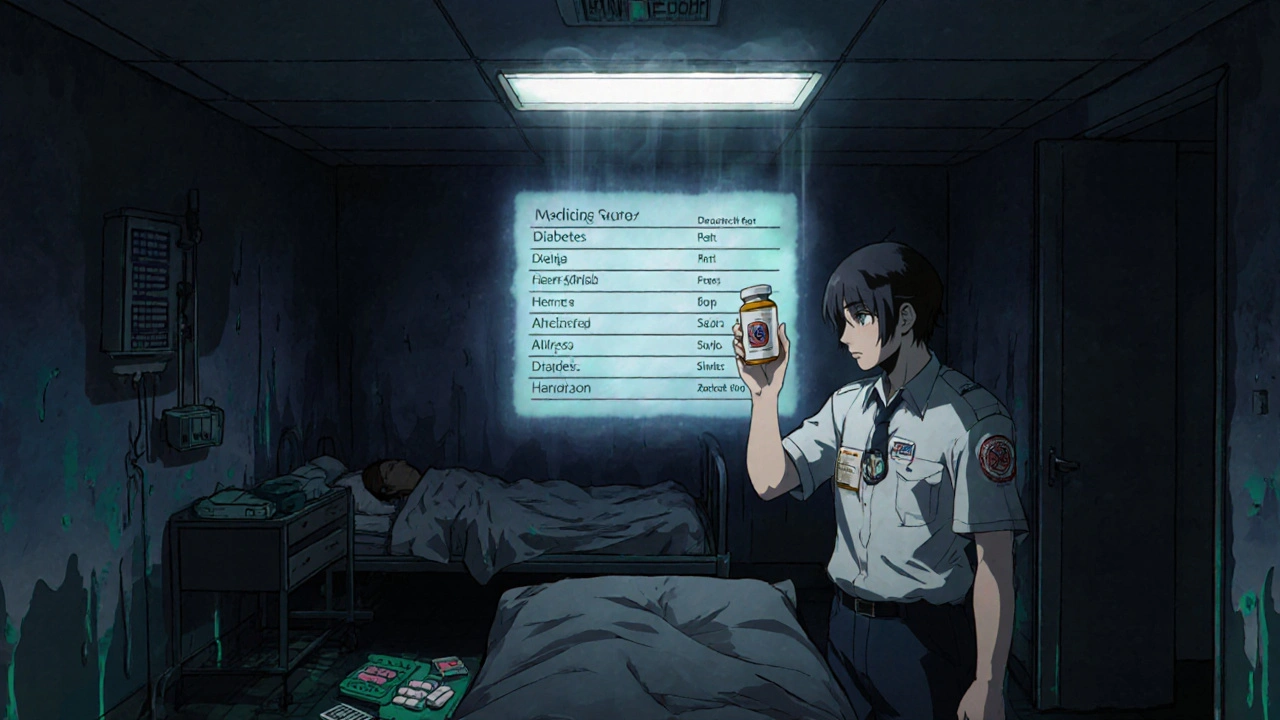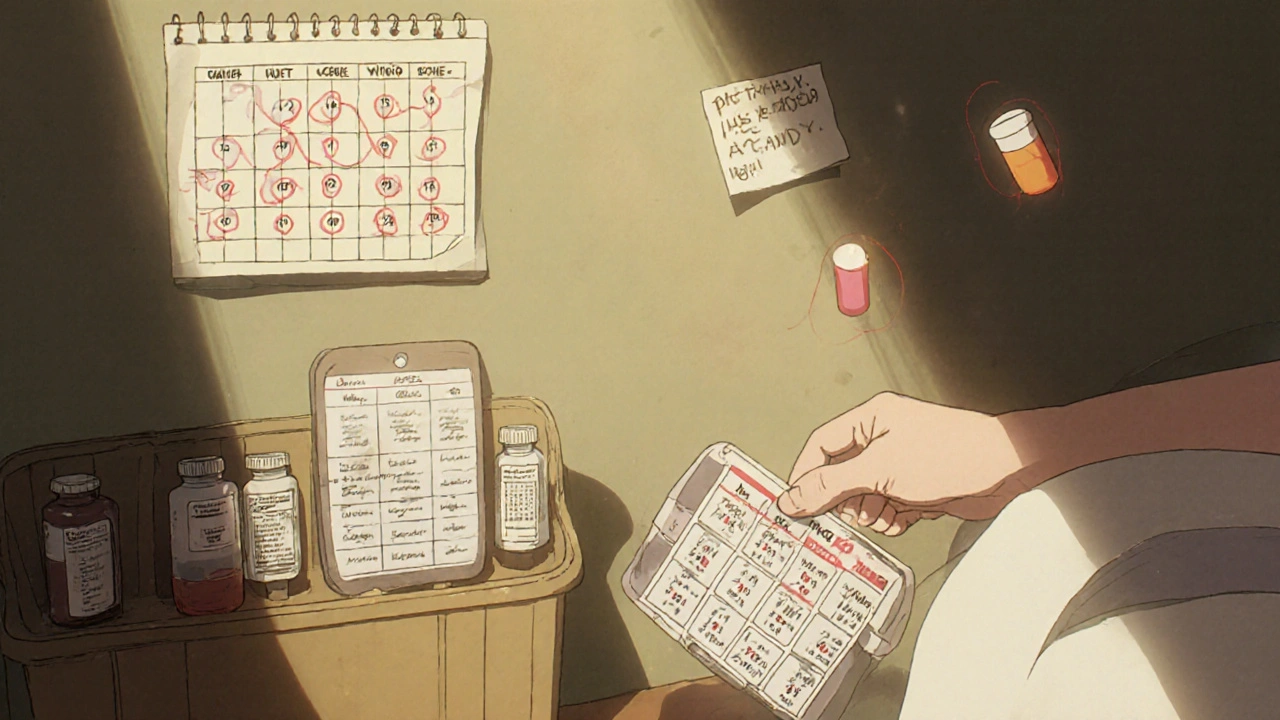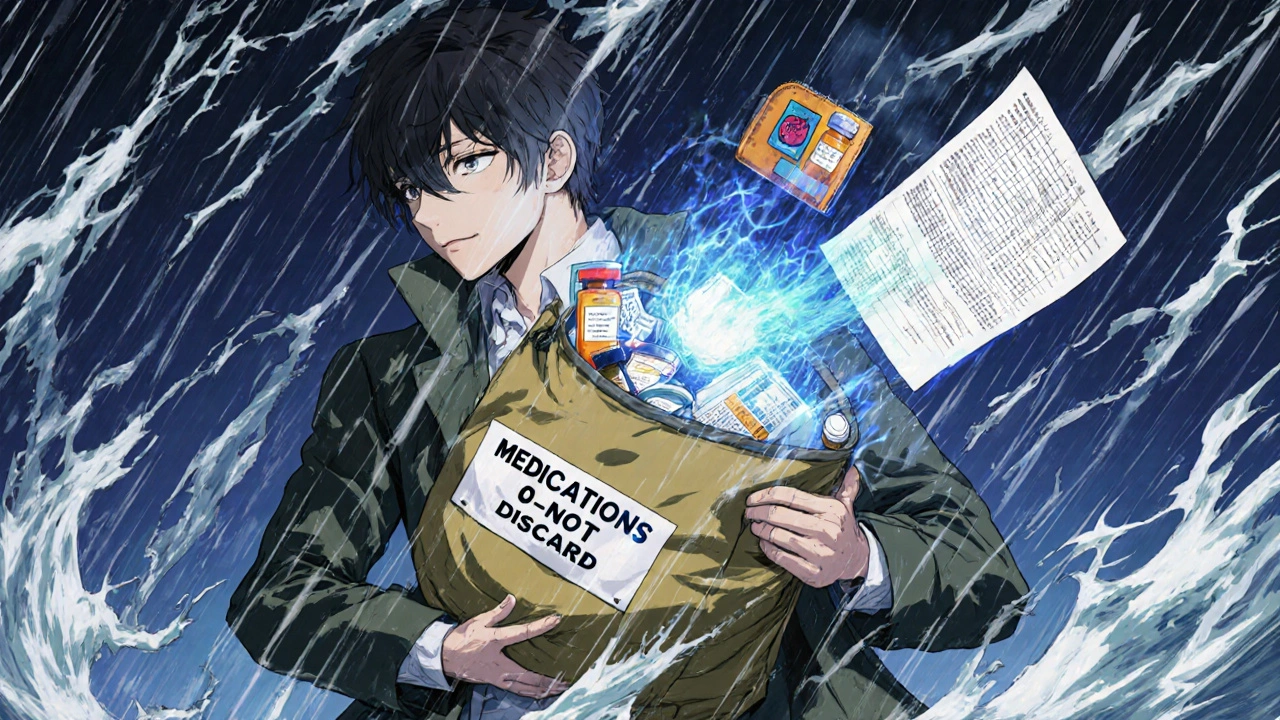Why Your Medication Go-Bag Could Save Your Life
When a hurricane hits, a wildfire spreads, or a power outage leaves you stranded, the last thing you want to worry about is whether your blood pressure pills or insulin are still safe to take. Yet, every year, thousands of people end up in emergency rooms not because of their injury or illness-but because they ran out of meds or their pills got too hot, too old, or just vanished in the chaos. A medication go-bag isn’t a luxury. It’s a lifeline.
According to the CDC, 89% of Americans over 65 take at least one prescription drug. That number jumps even higher when you include younger adults with diabetes, asthma, heart conditions, or mental health needs. And yet, only 22% of U.S. households have a go-bag with enough medication to last through an emergency. That’s not just risky-it’s dangerous.
What Exactly Goes in a Medication Go-Bag?
It’s not just about tossing bottles into a backpack. A proper go-bag follows clear, practical rules based on guidance from FEMA, the American Red Cross, and the CDC. Here’s what you actually need:
- A 14-day supply of every essential medication-including prescriptions and over-the-counter drugs like pain relievers or antacids. While some sources say 7 days is enough, real-world disasters like California wildfires and Hurricane Ian have shown that evacuations often last longer. Don’t gamble with your health.
- Original prescription bottles with labels intact. Emergency responders need to know exactly what you’re taking, the dosage, and why. A handwritten list isn’t enough. Labels have barcodes, expiration dates, and prescribing doctor info that can prevent deadly mix-ups.
- A printed medical summary for each person in your household. Include: full name, date of birth, primary care doctor’s name and number, list of all medications (with dosages and frequency), allergies, chronic conditions (like diabetes or COPD), and any advance directives or living wills.
- Emergency contact list with names, phone numbers, and relationships (e.g., "Sister: Jane Doe, 555-0123"). If you’re unconscious or disoriented, this info could be the difference between life and death.
- Specialized storage tools if you use temperature-sensitive meds like insulin, epinephrine, or biologics. A Frio Wallet or MedAngel ONE device can keep insulin cool for up to 48 hours without power. These aren’t optional-they’re critical.
- Small bottles of water and non-perishable snacks if you need to take meds with food or fluids. Some medications require hydration; others can’t be taken on an empty stomach.
Storage Matters More Than You Think
Storing your go-bag in the bathroom? Bad idea. Humidity ruins pills. Left in the car? Heat can break them down. A study by Consumer Reports found that insulin stored in a hot car for just 24 hours lost up to 30% of its potency. That’s not just ineffective-it’s dangerous.
Keep your go-bag in a cool, dry place. A high shelf in your bedroom closet works. Use a water-resistant, easy-to-carry container-something with a handle, not a plastic bag. Label it clearly: "MEDICATIONS-DO NOT DISCARD." If you have kids, lock it up. But make sure everyone in the household knows where it is.
And don’t forget: if you use an EpiPen, keep a spare. Epinephrine expires. And if it’s expired during an allergic reaction, it might not work. Check the date every time you refill your prescriptions.

How to Keep Your Meds Fresh and Ready
One of the biggest mistakes people make? They build their go-bag once-and forget about it. Medications expire. Batteries die. Labels fade. You need a system.
Here’s how to stay on top of it:
- Refill early. Ask your pharmacist for 60- or 90-day supplies instead of 30-day ones. That gives you extra pills to rotate into your go-bag without running out.
- Rotate every 3 months. When you refill your meds, take the new bottles and put them in the go-bag. Move the old ones to your regular medicine cabinet. This ensures your emergency supply is always current.
- Check expiration dates monthly. Set a phone reminder for the first of every month. If anything expires in the next 30 days, refill it immediately.
- Test your cooling devices. If you use a Frio Wallet or MedAngel ONE, run a test every few months. Put it in a warm room and see if it holds temperature. If it doesn’t, replace it.
Pro tip: Use a pill organizer with date labels. It’s easier to grab a week’s worth of pills if they’re already sorted. Just make sure the original bottles are still in the bag for official verification.
Special Cases: Diabetes, Heart Conditions, and More
Not all medications are created equal. Some need special handling.
- Insulin: Must stay between 36°F and 86°F. If your power goes out, your fridge won’t help. A Frio Wallet is the most reliable solution. Don’t rely on ice packs-they melt too fast.
- Epinephrine auto-injectors: These degrade quickly after expiration. Replace them on schedule. Keep two in your bag. One might not work if it’s old or damaged.
- Blood pressure and heart meds: These are the #1 cause of emergency room visits during disasters. Missing even one dose can trigger a heart attack or stroke. Never skip refills.
- Antibiotics and antidepressants: Stopping these abruptly can cause serious side effects. Make sure you have enough to last through a 14-day disruption.
The CDC says 38% of disaster-related ER visits are due to interrupted medication access-and nearly 3 out of 10 of those involve cardiovascular drugs. That’s not a coincidence. It’s a warning.
What to Do If You Can’t Get Your Meds
What if you’re evacuated and your go-bag is gone? Or your pharmacy is closed?
In 42 states, pharmacists can give you a 7-day emergency supply of most medications without a new prescription-if you can show proof you were taking them. That’s why your original bottles and medical list are so important. Bring them to the pharmacy. If you can’t find one, go to an ER. They’re required to stabilize you and give you a short-term supply.
But don’t wait. If you know a storm is coming, refill your meds before the power goes out. Don’t rely on last-minute help. The system is designed to help-but it’s not foolproof.

Real Stories, Real Risks
One Reddit user, "MedPrepRN," survived Hurricane Ian with only 7 days of meds. She was stranded for 11 days. "I almost ran out of my heart medication," she wrote. "I wish I’d listened to the two-week rule."
Another, "DisasterDoc2020," saw multiple diabetic patients show up in the ER after their insulin spoiled in non-cooled go-bags during California wildfires. "They were confused, shaky, barely conscious," he said. "All because they didn’t have a cooling solution."
On the flip side, a mother named "SurvivorMom" credits her go-bag’s detailed meds list with saving her son during a flash flood. "The paramedics didn’t know his history, but they had his list. They avoided a dangerous drug interaction. That paper saved his life."
Who Needs This Most?
You might think this is just for older adults. But the data says otherwise.
While 34% of people over 65 have a medication go-bag, only 18% of those aged 18-34 do-even though chronic conditions like asthma, Crohn’s disease, epilepsy, and mental health disorders are common in younger populations. If you take any daily medication, you’re at risk.
Climate change is making disasters more frequent. The National Academy of Medicine predicts a 40% rise in weather-related evacuations by 2030. With 157 million Americans managing chronic conditions, the need for go-bags isn’t growing-it’s urgent.
Start Today. Don’t Wait.
You don’t need to buy a fancy kit. A simple plastic bin with a handle, some ziplock bags, and a printed list will do. But you do need to act.
Here’s your 5-minute starter plan:
- Grab your current prescriptions. Count how many days you have left.
- Call your pharmacy. Ask if you can get a 90-day refill now.
- Print your medical summary (ask your doctor’s office for a template if you need one).
- Buy a Frio Wallet if you use insulin or epinephrine.
- Put it all in a bag. Put the bag where you can grab it in 10 seconds.
Do this now. Not tomorrow. Not when the next storm is on the news. Do it today. Because when disaster hits, you won’t have time to think. You’ll only have time to act.
Do I need to keep my medications in their original bottles?
Yes. Emergency responders, pharmacists, and hospitals need to verify the medication by its label-dosage, prescribing doctor, expiration date, and pharmacy info. A handwritten list isn’t enough. Original bottles are legally recognized proof you’re taking what you say you are.
Can I carry my meds in a pill organizer instead of bottles?
You can use a pill organizer for daily use, but always keep the original bottles in your go-bag. The organizer is for convenience; the bottles are for verification. Never leave the bottles behind.
What if my medication needs refrigeration?
Use a cooling device like the Frio Wallet or MedAngel ONE. These are designed to keep insulin, epinephrine, and other temperature-sensitive drugs safe for 48+ hours without power. Ice packs aren’t reliable-they melt too fast and can freeze your meds.
How often should I check my go-bag?
Check expiration dates every month. Rotate meds every 3 months. Replace cooling devices every 1-2 years, or as recommended by the manufacturer. Don’t wait until an emergency to find out your insulin is expired.
Is it legal to carry prescription meds in a go-bag?
Yes, as long as the medications are in their original labeled containers and are for personal use. The FDA and DEA allow this for emergency preparedness. Never carry someone else’s meds-even if they’re a family member.
What if I forget my go-bag during evacuation?
Go to the nearest pharmacy with your medical list and ID. In 42 states, pharmacists can give you a 7-day emergency supply without a new prescription. If that’s not possible, go to an ER. They’re required to stabilize you and provide short-term meds. But don’t rely on this-always have a backup.

